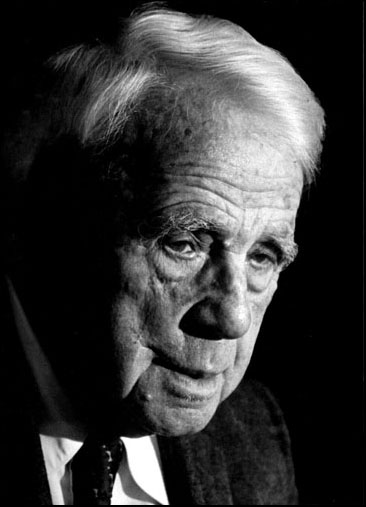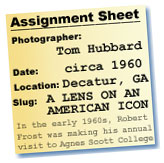A LENS ON AN AMERICAN ICON
by Tom Hubbard
Emeritus Prof. Ohio State School of Journalism and Communication
In the early 1960s, Robert Frost was making his annual visit
to Agnes Scott College. He came yearly
to visit the president and
talk to students at Agnes Scott, a women’s college in
Decatur, Georgia, near Atlanta. The college held a news conference
for
Frost

Robert Frost
© Tom Hubbard
Emeritus
Prof. Ohio State School of Journalism and Communication
|
|
In
those days a news conference, even in Atlanta, with Robert
Frost, was a small affair. That afternoon, the media
was about six people. There was a cameraman from each of
the
three TV stations, a daily and weekly papers sent reporters
or photographers. I was shooting stills. My previous
impression of Frost’s public persona was he was kindly
old man who personified the sentiments of his poems.
Maybe our small group antagonized him, but that afternoon,
he was a cranky old guy ready to fight. Atlanta had not achieved
its reputation as a sophisticated, cosmopolitan city. Upright
New Englander Frost may have thought he was among the unwashed,
ignorant masses.
The first question
started it. (A big, unrelated story of the time was the pronouncement
by a theologian in a nearby college, “God is dead.” I
think the professor meant the opposite, but he got attention.
That’s another story.)
The first question
was, “Mr. Frost, is poetry dead?” The reporter
thought he was asking a friendly, provocative opening question.
Robert Frost, the nation’s kindly old grandfather
turned belligerent. “How dare you ask ME that!” If
Frost was younger, I think he would have beaten him up.
Frost sputtered invective at the cringing reporter. He
questioned the reporter’s intellect
|
He turned to the rest of us and talked about “that guy.” We
all caved. No one risked explaining it was just a way of getting
fresh remarks out of Frost.
Let’s go back to just before the news conference opened.
In those days, a TV station might send only a cameraman to such
a news conference, armed with list of prefabricated questions.
The cameraman (it was literally “cameraman” in those
days.) would set up the heavy Auricon sound camera, ask the questions
and film the answers. This would be reconstructed on the air,
with the anchor asking the questions. The cameraman was in no
sense
the interviewer. He just read questions, never venturing even
a follow-up question.
Before the news conference opened, Frost was the kindly old man
we expected. The cameraman decided to help Frost by reading
his set of three questions, so Frost could formulate answers
before
the camera rolled.
Frost didn’t understand this. He thoroughly answered each
question during the run-through. Frost was concentrating on the
answers, but he may have detected a slight condescending look on
the cameraman’s face.
The cameraman didn’t waste any of his precious three minute
roll of film on the meandering news conference. When his one-on-one
time came, he turned on his camera and sat near Frost and asked
his first question. Frost started into the answer. About three
sentences in, he paused and said, “You’ve already
asked me that. Ask me something different.
The cameraman tried to explain run-through, but went on to his
second question. Frost, “You’ve asked me that too.
Get some new questions.” Today a new set of questions would
be quickly forthcoming via cell phone. That day, the cameraman
slinked off to attempt his daunting task.
In those days, it didn’t take a college degree to lug a news
camera. The cameraman may have had only a vague idea of who Frost
was, and certainly did not want to risk another question that would
bring down this old guy’s wrath again. It was the toughest
writing assignment I ever observed. I don’t think he ever
did come up with fresh questions.
The affair went on for about 20 more minutes. We enjoyed coffee
and cookies and deferential chats with Frost. I glanced occasionally
at the TV cameraman over in the corner by a window, trying
to compose three more questions.
I’m grateful to the hapless cameraman for his light which
illuminates the accompanying photo of Frost. They always clamped
a reflector flood on the film camera. It was safe, straight-on
light suitable for black and white TV. I could “ride” his
light by standing to the side and getting wonderful, dramatic side
lighting. I don’t think my standard joke, “Thanks for
the light,” amused the cameraman that day.
Knowing the situation, I see two Robert Frosts in the photo.
One is the kindly old public man we know. If you look again,
you might
see the power and anger of a truck driver you have just inadvertently
insulted on the next bar stool. I’ve always cherished the
thought that I know both Robert Frosts.
Tom Hubbard
Emeritus Prof. Ohio State School of Journalism and Communication
hubbard.1@osu.edu
|

